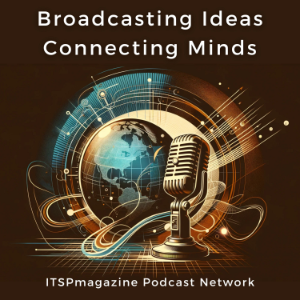
ITSPmagazine
Technology Podcasts
Broadcasting Ideas and Connecting Minds at the Intersection of Cybersecurity, Technology and Society. Founded by Sean Martin and Marco Ciappelli in 2015, ITSPmagazine is a multimedia platform exploring how technology, cybersecurity, and society shape our world. For over a decade, we've recognized this convergence as one of the most defining forces of our time—and it's more critical than ever. Our global community encourages intellectual exchange, challenging assumptions and diving deep into the questions that will define our digital future. From emerging cyber threats to societal implications of new technologies, we navigate the complex relationships that matter most. Join us where innovation meets security, and technology meets humanity.
Location:
United States
Genres:
Technology Podcasts
Description:
Broadcasting Ideas and Connecting Minds at the Intersection of Cybersecurity, Technology and Society. Founded by Sean Martin and Marco Ciappelli in 2015, ITSPmagazine is a multimedia platform exploring how technology, cybersecurity, and society shape our world. For over a decade, we've recognized this convergence as one of the most defining forces of our time—and it's more critical than ever. Our global community encourages intellectual exchange, challenging assumptions and diving deep into the questions that will define our digital future. From emerging cyber threats to societal implications of new technologies, we navigate the complex relationships that matter most. Join us where innovation meets security, and technology meets humanity.
Twitter:
@ITSPmagazine
Language:
English
Website:
https://itspmagazine.com/
Email:
hello@itspmagazine.com
CI/CD Pipeline Security: Why Attackers Breach Your Software Pipeline and Own Your Build Before Production | AppSec Contradictions: 7 Truths We Keep Ignoring — Episode 4 | A Musing On the Future of Cybersecurity with Sean Martin and TAPE9 | Read by TAPE9
Duration:00:03:38
Halloween over Florence: THE MARKET OF GHOSTS | A Short Story Written By Marco Ciappelli (English Version) | Stories Sotto Le Stelle Podcast | Short Stories For Children And The Young At Heart
Duration:00:13:02
New Book: SPIES, LIES, AND CYBER CRIME | Former FBI Spy Hunter Eric O'Neill Explains How Cybercriminals Use Espionage techniques to Attack Us | Redefining Society And Technology Podcast With Marco Ciappelli
Duration:00:48:16
Sampling, Stealing, or Something Else Entirely: Who Gets the Credit When AI Creates the Song? | A Conversation with Marco Ciappelli | Music Evolves with Sean Martin
Duration:00:29:57
From Sampling to Scraping: AI Music, Rights, and the Return of Creative Control | A Musing On The Connection Between Music, Technology, and Creativity | Music Evolves: Sonic Frontiers with Sean Martin and TAPE9 | Read by TAPE9
Duration:00:10:18
The Silent Risk in AI-Powered Business Automation: Why No-Code Needs Serious Oversight | A Conversation with Walter Haydock | Redefining CyberSecurity with Sean Martin
Duration:00:38:21
Beyond the Title: What It Really Takes to Be a CISO Today — Insights Following A Conversation with Solarwinds CISO, Tim Brown | A Musing On the Future of Cybersecurity with Sean Martin and TAPE9 | Read by TAPE9
Duration:00:08:26
First CISO Charged by SEC: Tim Brown on Trust, Context, and Leading Through Crisis - Interview with Tim Brown | AISA CyberCon Melbourne 2025 Coverage | On Location with Sean Martin and Marco Ciappelli
Duration:00:26:54
Everyone Is Protecting My Password, But Who Is Protecting My Toilet Paper? - Interview with Amberley Brady | AISA CyberCon Melbourne 2025 Coverage | On Location with Sean Martin and Marco Ciappelli
Duration:00:28:05
Beyond Blame: Navigating the Digital World with Our Kids - Interview with Jacqueline (JJ) Jayne | AISA CyberCon Melbourne 2025 Coverage | On Location with Sean Martin and Marco Ciappelli
Duration:00:24:32
The Once and Future Rules of Cybersecurity | A Black Hat SecTor 2025 Conversation with HD Moore | On Location Coverage with Sean Martin and Marco Ciappelli
Duration:00:23:37
AI Creativity Expert Reveals Why Machines Need More Freedom - Creative Machines: AI, Art & Us Book Interview | A Conversation with Author Maya Ackerman | Redefining Society And Technology Podcast With Marco Ciappelli
Duration:00:43:24
When the Coders Don’t Code: What Happens When AI Coding Tools Go Dark? | A Musing On the Future of Cybersecurity with Sean Martin and TAPE9 | Read by TAPE9
Duration:00:09:35
Lo-Fi Music and the Art of Imperfection — When Technical Limitations Become Creative Liberation | Analog Minds in a Digital World: Part 2 | Musing On Society And Technology Newsletter | Article Written By Marco Ciappelli
Duration:00:14:33
The Hidden Cost of Too Many Cybersecurity Tools (Most CISOs Get This Wrong) | A Conversation with Pieter VanIperen | Redefining CyberSecurity with Sean Martin
Duration:00:52:20
SBOMs in Application Security: From Compliance Trophy to Real Risk Reduction | AppSec Contradictions: 7 Truths We Keep Ignoring — Episode 3 | A Musing On the Future of Cybersecurity with Sean Martin and TAPE9 | Read by TAPE9
Duration:00:02:33
AI Will Replace Democracy: The Future of Government is Here. Or, is it? Let's discuss! | A Conversation with Eli Lopian | Redefining Society And Technology Podcast With Marco Ciappelli
Duration:00:36:35
Why Identity Must Come First in the Age of AI Agents | A Black Hat SecTor 2025 Conversation with Cristin Flynn Goodwin | On Location Coverage with Sean Martin and Marco Ciappelli
Duration:00:21:45
How F-Secure Transformed from Endpoint Security to Predicting Scams Before They Happen | A Brand Story Conversation with Dmitri Vellikok, Product and Business Development at F-Secure
Duration:00:36:23
Why Cybersecurity Training Isn’t Working — And What To Do Instead | Human-Centered Cybersecurity Series with Co-Host Julie Haney and Guest Dr. Aunshul Rege | Redefining CyberSecurity with Sean Martin
Duration:00:45:26
